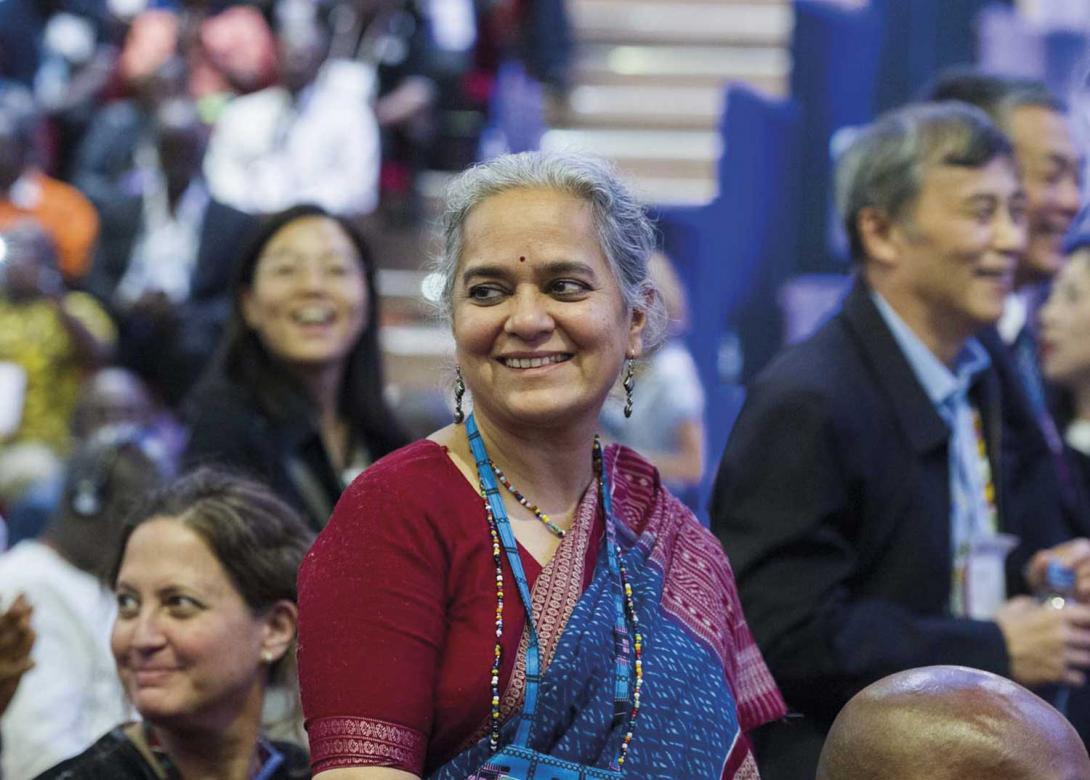
“People told us that they could not pull themselves out of poverty without basic medical care”
Mirai Chatterjee, Founder of the Indian cooperative Lok Swasthya SEWA
In 1984, Mirai Chatterjee had already realized that the health problems involved in certain Jobs would require the creation of a medical care cooperative to successfully promote the cooperative model for working methods, something that today we take for granted. Its beginnings in India were not easy, but the model ended up being successful and since then it has improved the working and healthcare conditions affecting millions of women in India.
What do you remember about the early stages?
In the early years of our health work, there was not much of a public health system. It was mainly focussed on family planning in the early 1980’s. Therefore, SEWA health workers had to step in and provide primary health care, including low cost medicines door-to-door for local people, especially women. It was a challenging time but one full of innovation and experimentation. We trained local women, our SEWA members, to be health workers for their urban and rural communities. They developed health care based on local needs. In 1989 we thought of developing a health cooperative. It was unheard of. The registrar of cooperatives took 2 years to register us formally. But we kept working at the grassroots. To their credit, the cooperative department of our state of Gujarat, decided to take risk and register India’s first health cooperative of grassroot health workers. Our SEWA sisters have not let them down. We are a fully financially viable health cooperative for the last 29 years, run and owned by the health workers themselves. But yes, in the early days the challenges were considerable, more at the policy level. Women at the grassroots were ready to take health action and serve their communities from the very beginning.
What was SEWA’s initial goal?
The Self-Employed Women’s Association (SEWA) is a national union of 1.8 million women workers of the informal economy in India in 18 states, set up in 1972 by Ela Bhatt, a labour lawyer and union organiser. Informal workers constitute more than 90 per cent of the Indian workforce of about 500 million workers. Reaching even basic health care to such a large population, all these workers and others in a total population of 1.2 billion is always going to be a huge challenge. In addition, we are a very diverse nation, different cultures, communities and languages, among other differences. Context is important. One size cannot fit all.
We realised this very early at SEWA when we saw that the health care system in the early days almost 50 years ago, and even today, does not adequately address the needs of the mass of the Indian workforce, especially women. Our members tell us that they cannot come out of poverty without basic health care, to keep them healthy and productive and to prevent high out of pocket health expenditure. They said their dreams of economic empowerment and self-reliance could never be met if they were constantly sick and did not have access to affordable and appropriate health care. “Our bodies are our only assets,” they explained. As long as we are healthy we can work and earn and feed our children.” Therefore, SEWA began a campaign for health education and awareness called “Know Your Body”, focusing on wellness and how to stay healthy. This developed into a full-fledged, community-based primary health care programme which, in turn, developed into a health cooperative called Lok Swasthya SEWA or People’s Health cooperative.
SEWA’s goal is to organise women for full employment and self-reliance. Full employment means work and income security, food security and social security. The latter includes health care, child care, pension, insurance and housing with basic amenities like a tap and toilet in every home. Thus, health care is imbedded in SEWA’s goal right from the very beginning. Self-reliance means both financial viability and also decision-making in women’s control through their own democratically-elected boards and committees. Our health cooperative is working with the rest of the SEWA movement for both full employment and self-reliance.
How did you manage to build up such a broad, strong organisation?
SEWA’s Founder, Ela Bhatt, was actively involved in the student movement during our freedom struggle. She and her husband organised at the grassroots level. So very early on she understood the power of organising people at the local level for social change towards a society based on inclusion, justice and equality, especially for women in a patriarchal society such as India. Therefore, to she began to organise women workers, the poorest and most vulnerable of Indians. Soon it was clear that to sustain organising and build up solidarity, we need strong organisations, democratic, membership-based, sustainable and in women’s control. It is only through organising and building up membership-based organisation of the poor (MBOs) that their collective strength can be developed for lasting and sustainable social change. Mahatma Gandhi’s values of truth and non-violence, inclusion of all, and local decentralised development were our guiding principles. Therefore, we helped women create their own, local organisations where they are the users, owners and managers or leaders. SEWA started out as a trade union and in time has become a movement of more than 5000 small, medium and quite large organisations of women workers. I think this is how over almost five decades now we built up a broad-based and strong movement comprising many membership-based organisations of women workers.
What was the most complicated part?
Without a doubt, the most complicated part was organising women and helping them develop unity, solidarity and sisterhood. That is the bed-rock of all our work. It was the first and most difficult step forward in a country with so many divisions and differences, of caste, class, religion, ethnicity, language and geography. Today women have seen the power of their organising and so it is not quite as hard or complicated, though it remains a challenge in new areas.
Another complicated or challenging part was building up sustainable membership-based organisations, it remains a challenge today. These must be used, run and owned by women and must be financially viable and also led by them. This is a work in progress.
Would it have been possible to achieve this success without relying on community action?
Community action, or what we at SEWA call organising, is the basic first step. We could not have moved forward without this. This is a slow and steady process of uniting hearts and minds, beginning with the needs and concerns of the members who are the heart and soul of SEWA.
How did you manage to make the Indian government apply health programmes that had previously been developed by SEWA?
At SEWA we have always undertaken policy action for laws and policies in favour of the poor and women, and with a workers’ perspective, whether it was for the rights of street vendors to sell in the bazaars of India or for basic health care. Therefore, we engaged with local health authorities from the beginning. We also brought out the health-related concerns and needs of our members to the local, state and national authorities, our government. We took these also to the international level, to the WHO, to ILO and the ICA.
As we were in constant dialogue with the public health system in India and also because we ourselves were engaged in action, providing primary health care services to women and their families, the government listened. They realised that we had some workable health programmes that were suited to women’s and local people’s needs. Some examples of this are the adoption of our idea for maternity benefits for informal workers by our state government and our low-cost pharmacies that were taken up by the national government. We also, along with many others, advocated for front-line health workers to be women at the local level. Today, these women are called ASHAs in the government’s national health mission and are the pillars of our public health system in India.
I think one successful part of our strategy to effect policy change is getting women leaders from the grassroots themselves present their issues to policy-makers and legislators. They got voice and representation at the policy table because they organised into their own union and health cooperative.
With hindsight, has SEWA exceeded your expectations?
It has been a wonderful journey, and continues to be so. I feel very privileged to serve for the past thirty-five years at SEWA. It is a dream vocation as a public health worker. I also succeeded the Founder, Ela Bhatt, as General Secretary of SEWA union for some years which I had never expected or imagined. I have had so many opportunities to serve the poor, hard-working women of our country. I could not have asked for anything better.
You are a great defender of healthcare cooperativism. What is the outstanding reason behind the incredibly good results given by this method?
I think health is not something to be delivered. We have to take charge of our own health and well-being. That is what Mahatma Gandhi who inspires us even today taught us many years ago. He experimented with health action himself and concluded that each of us has to strive to be healthy. Of course, the state or government has a very important role and responsibility. But we have seen that in a large, diverse and rather complex country like India, planning, implementation and monitoring of all health action and programmes must be done locally and in local people’s control, and preferably by women because they are the poorest, and we have found that they are ready to serve others and are inclusive. It also empowers them and can help to reduce gender discrimination.
If health action, including implementation, is to be done locally and in a decentralised manner and in people’s control, then what better way to do this other than through women’s own health cooperative? In cooperatives, people are the users, owners and managers. They put up the share capital. They are share-holders and thus owners. They are also democratically elected to the cooperative’s board and so run it. They can decide then what are their health concerns and what to do about it, how to access public health services and how to develop their own services to fill in gaps. And when people run their own health programmes and have a stake in these, then they show good results. Our health cooperative has consistently been posting surpluses and giving dividends and has been adjudged an A grade cooperative for the last 28 years because it is run by women cooperative members.
Today our government has also realised the centrality of community action, and calls for a people’s movement for universal health care in their health policy document of 2017. At the national level there is an advisory group for community action, including health care through cooperatives or collectives. I represent SEWA and our health cooperative, Lok Swasthya, in that group.
What are the decisive factors for it to become effective?
First and foremost: organising. Women at the grassroots must be organised into their own membership-based organisations like unions and cooperatives. I believe health cooperatives or similar type of collectives run by women themselves are the best way to reach health care to local people. Without these, our public health programmes will not have the reach they hope for in a country of our size and diversity.
Second, planning, implementation and monitoring must be entrusted to local people, preferably women, who will ensure that this gets done in a transparent and appropriate way. And low cost too. Then only will we truly have a people’s movement for health in India.
Is the involvement of international governments, organisations and institutions important?
Yes absolutely. We need the support of the international community for new ideas and approaches to health care. Many countries like Thailand and Sri Lanka have shown the way to health in our neighbourhood. Our sister countries like Nepal and Bangladesh have made considerable progress on the road to health, though they are poorer than India. So, we have much to learn from others. In turn, we do have things to contribute as well. Once an Ethiopian colleague told me that if there is one country that holds much relevance for the continent of Africa it is India. Being diverse and poor, we have come up with many approaches to health, tailored to different contexts. There are useful lessons to be shared and learned from others.
Also, when WHO, UNICEF, UNFPA, UN Women and ILO, among others develop policies and new approaches, India participates in the processes, and also adopts these. One such example is the Cairo Conference, the International Conference on Population and Development (ICPD) in 1994. It changed the paradigm of reproductive health in India from one based almost entirely on family planning to a more holistic one based on women’s rights and also women’s health needs more broadly.
We at Lok Swasthya health cooperative look forward to working with IHCO and its member cooperatives to work for universal health care everywhere on our planet, and in a way that puts people in the centre.
What needs to be improved in the world of healthcare cooperativism?
We are new members of the IHCO. We have a lot to learn from other cooperatives. Our own experience shows that health of communities improves when local health cooperatives like Lok Swasthya are set up with women in the centre of all efforts. Therefore, I hope that we can create health cooperatives that are bottom-up, starting with front-line health workers and local people’s health needs, and then going forward from there. Our experience shows that this way we can build up viable cooperatives taking unchartered paths and innovative health action, like running low cost pharmacies and now Ayurvedic medicines production, mental health services through barefoot counsellors and more.
I think cooperatives in general are not very well understood and health cooperatives perhaps even less so. Maybe the Spanish case is an exception. I think we need to reach out pro-actively to WHO more and also to countries to show impact of health cooperatives and how these can led people forward to universal health care.
You have travelled the world over to explain your experiences. Can your successful case be applied in other countries?
I believe it very much is applicable to other countries, especially in the global South. The organising approach to health and developing health cooperatives is not unique to India. We need to organise people in every country for people-led health care. It will more appropriately answer people’s health needs, based on their own local context. When services are provided locally, and by local people, then is it not only an appropriate model but also low cost and sustainable. Large corporate hospitals will never be able to address the primary health care needs of people, though they may serve to provide tertiary care. In addition, the organising approach can help local people obtain access to the social determinants of health: early childhood care, water and sanitation, gender justice, employment and more.
I think the SEWA experience through the Lok Swasthya health cooperative shows that local women can take charge of their own health and that of their communities in a sustainable manner. Of course, we need public health programmes and investment by the government. But the cooperatives address the last mile issues and link local people with the public health system, and private too where required, and also fill in important gaps like mental health and occupational health.
Is the lack of investment on the subject of healthcare today’s most important problem?
It is certainly a major issue in public health today in India where just about 1.2% of Indian GDP is spent on public health expenditure. Much of this is spent on large tertiary care hospitals and salaries of government health personnel. Though there is increased expenditure recently in a new health programme called Ayushman Bharat, it is still not near the 2.5-3% of GDP that some of us has suggested in 2011 in the report we undertook on how to reach universal health care to Indians. So, I would put it top of the list along with investment specifically in comprehensive primary health care.
Having said this, I must add that budget allocation though necessary is not enough. We need to undertake a whole set of health reforms if we are to move towards universal health care as outlined in the National Health Policy 2017. These would include community action for health, a basic primary health care package, affordable referral care and affordable drugs, among others.
How do you see the future for cooperatives?
I firmly believe that cooperatives are the way of the future. Greed and competition have brought our planet to the brink of disaster. We cannot have climate justice without justice in other quarters, between countries and within too. We will not have health for all nor will we have reduction in poverty and vulnerability if we do not work in ways that foster cooperation and concern for the planet. We have to re-discover doing this locally and in a low-cost manner. It is not new, but we have forgotten cooperation, collaboration and partnerships which have been the way of all in the human family from time immemorial. Of course, the cooperative movement and traditional communities in all continents keep reminding us of how cooperation, sharing, collective action and cooperatives can build a better and sustainable future together, and for all of humankind.
Therefore, I am very convinced of the future of cooperatives, cooperating, supporting each other, stressing our inter-connectedness, sharing resources and reducing inequality. It is a challenge. We are swimming against the tide but it will be the way of the future. Our own experience at SEWA shows that local people join cooperatives with enthusiasm, especially the poorest. It is also a way for young people to obtain work, employment and income while contributing to society. Cooperatives knit people together. They are the much-needed glue to bring together all in our increasingly polarised world. They build local leadership and innovation. They tend to be close to the grassroots and respectful of the environment. For all these reasons then, I see that the future of cooperatives is very bright!
Of course, there remains much to be done at the policy level to enable the growth and prosperity of cooperatives. In India, forming cooperatives is a fundamental right under our Constitution since 2012. But we need to convert this important right into reality. Many of our states have laws that restrict autonomy of cooperatives. They make it hard to function as a cooperative. This must change or else people will find other organisational models based on cooperative principles.
Still, my own experience of over 30 years with cooperatives makes me optimistic about them as a way of organising informal workers, especially women, and creating an environment based on social justice, health justice, climate justice and inclusion.




